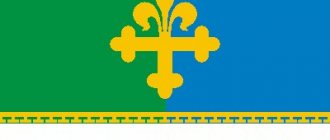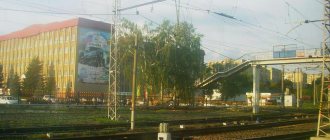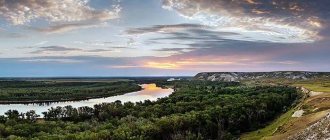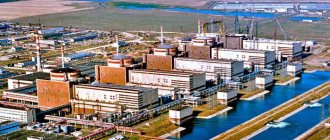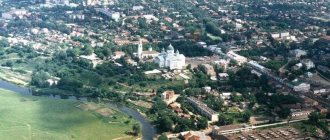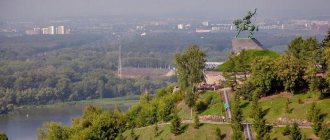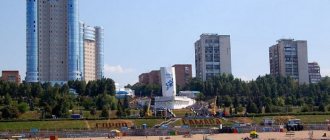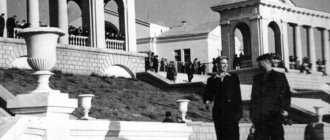General facts
Partially the center of the hero city is 10-12 meters below sea level. And the Volgograd hydroelectric power station is the largest in Europe. The longest street in Russia is located in Volgograd - this is the 2nd Longitudinal Highway. Its length is 50 km, and in fact, calling it a street is not entirely correct, because it is a highway where one street simply turns into another. But hardly anyone will argue with the fact that Volgograd is the longest Russian city - it stretches along the banks of the Volga for more than 100 km.
The length of the bridge across the Volga is 7100 meters, it is the fourth longest among all Russian bridges. The famous monument to Lenin, installed on the embankment in the Krasnoarmeysky district of the city, is listed in the Guinness Book of Records due to its 57-meter length.
The Mamayev Kurgan memorial complex is one of the Seven Wonders of Russia. But this does not prevent Volgograd from bearing the status of the poorest of the Russian cities with a population of over a million, with the lowest level of wages.
Beaches of Volgograd
Where are the beaches of Volgograd on the Volga and Don, where you can swim in the summer in the city and its environs - we will talk about this in this article. We will present the best sandy beaches of Volgograd - paid and free, wild and official with photos, descriptions, addresses and position on the map, and also find out where the recreation centers and hotels with a beach on the Volga are located.
It is difficult not to notice in the name of Volgograd the name of one of the greatest rivers in Russia - the Volga. It is here that the most attractive beaches and recreation areas for city residents are located. It would seem that the significant length of the million-plus city along the river should have contributed to the appearance of several dozen equipped beaches.
Unfortunately, this fact turns out to be the opposite: on the right bank, where the main part of the city is located, they can be counted on one hand. The few sections with a gentle sandy entrance can be difficult to see on the map among the smooth, concrete-reinforced banks. But it is also impossible otherwise, since the destructive power of the river is very great. Recreation areas receive updates from time to time in the form of new bins or changing rooms. At the moment, most of them are not equipped, although those that are available are still a good opportunity to sunbathe and cool off by the water without leaving the city. Guests of Volgograd come, first of all, to memorable historical places, as can be learned from the reviews of tourists.
There is no central city beach in Volgograd for 2022 yet. It was planned to develop the site, beloved by the townspeople, in the area of the Central Park of Culture and Culture in time for the World Cup in 2022.
The left bank is longer and mostly free of stone and concrete. On it there is a small satellite town of Krasnoslobodsk, farms and dachas. Some banks are very wide and spacious, accessible places for recreation are complemented by the large islands of Sarpinsky and Golodny, as well as smaller ones in the Volga-Akhtuba floodplain. You can get to them by private water transport or regular ferries from the right bank.
The options for summer holidays are limited not only to the Volga. In the vicinity of the city there are lakes and ponds, natural or artificial reservoirs left after quarrying. Unlike a large river, shallow waters warm up faster and make it possible to swim comfortably already in the first hot days.
The beaches of Volgograd can only partially be divided into official and wild, since the number of the former in the last couple of years is small and varies from one to three. The most permanent of them is “Mayak”. Other places also undergo water inspection and may be safe in the water, but the lack of minimum conditions of civilization does not allow them to be opened. Please note that even paid beaches cannot guarantee officially approved swimming.
Seasonal features of beach holidays in Volgograd include a longer warm season than in the main part of central Russia. Temperatures can reach +20 °C in both May and September, although the river waters are still cold in the spring. July and August are truly summer months in Volgograd - the thermometer often rises to above +30 °C, and in such weather the beaches are always relevant.
A little history
Museums appeared in Volgograd “with the light hand” of Peter the Great, who during his visit presented the townspeople with his cap and cane as a gift. They became the first museum relics of the city.
The first tram lines appeared in Volgograd, which during the Russian Empire was called Tsaritsyn. By the way, this name did not arise at all as a result of an attempt to dedicate an entire city to the royal person - it was just that the Turkic words “Sary-chin”, meaning a beautiful or yellow island, were somewhat distorted in Russian. The very first enterprise that appeared in the city in time immemorial was a mustard factory.
During the uprising of Stepan Razin, his troops first captured Tsaritsyn, although the gates were opened to the ataman by the archers, most of whom went over to his side. But during the rebellion of Emelyan Pugachev, the situation was the opposite - Tsaritsyn remained the only city that did not surrender.
Central Embankment
The embankment of the 62nd Army is located in the central area of the city, here you can admire the landscapes of the Volga and take a ride on a cruise ship to the Volzhskaya hydroelectric station.
The Alley of Heroes, 360 meters long, connects the embankment with the very center of the city, zero kilometers, and the eternal flame. Next to it is a unique natural monument, the Poplar on the Square of Fallen Fighters, which carried its life through the great battle.
It’s especially beautiful here in the evening, when the lampposts light up and the alley becomes more than just a boulevard in the city center.
Train Station
The Volgograd railway station cannot be called an outstanding architectural structure, but it, like everything else, is important for the city. In 2013, a duplicate of the Barmaley fountain was installed near the central entrance, which delighted residents in the pre-war period. During the Soviet Union, they were installed in many cities.
Light Rail
The Volgograd high-speed tram is a kind of hybrid of the metro and a regular tram. The route layout is quite simple, there is only one branch that goes along the Volga. This type of transport is considered the most convenient for tourists; it allows you to visit the most important places in the city. Its significance is recognized not only by city residents, but also by the editors of Forbes magazine, which included it in the list of the 12 most interesting tram routes in the world.
Panorama Museum "Battle of Stalingrad"
The main museum dedicated to the Great Patriotic War, which consists of 8 halls. You won’t be able to quickly walk through them; the abundance of exhibits, personal belongings of soldiers, and real photographs will make you linger here for the whole day.
An interactive map of the city is one of the main exhibits; with the help of projection, military actions are reproduced and the city seems to come to life. On the top floor of the museum there is a panoramic canvas, 16 meters high and 120 meters long. It mainly shows the final stage of the War, Operation Ring.
City infrastructure
Finding a place to stay in Volgograd is not difficult. There are many hotels of different levels here. You can also rent an apartment (find out more), which is even cheaper, considering that you can cook your own meals instead of paying extra in a cafe or restaurant.
Transport system
In recent years, Volgograd's transport system has improved significantly. New buses have appeared on routes, modern stops have appeared with information boards and transport arrival times. This is a definite plus for tourists and foreigners.
The Second World War
The Battle of Stalingrad, which lasted 200 days, is considered the largest land battle of the Great Patriotic War. During this time, about a million people died. Of the 450 thousand Stalingrad residents who lived in the city before the war, only 32 thousand people remained alive. For another six months after the end of the Battle of Stalingrad, the corpses of people and horses were buried, which littered the city streets.
Due to bombing during the Great Patriotic War, the city was almost completely (90%) wiped off the face of the earth, as a result of which there were even proposals to rebuild it in another place, but the local administration rejected this idea and the city, then called Stalingrad, was scratch was revived in its original place.
The legendary “Motherland” at the time of its construction was the tallest monument in the world.
City on the Volga and modernity
The heroic past of Volgograd attracts tourists from all over the world, this is especially noticeable during the May holidays. Since most of the attractions are concentrated in the center, here you can find many hotels, hotels and guest houses for every taste and budget.
However, the leading role in the life of a modern city is still occupied not by tourism, but by industry. The city has developed mechanical engineering and defense production, metallurgical production, construction, chemical and food industries, and energy.
Industry of Volgograd
In addition, Volgograd is a port of five seas. The Volga-Don Canal united the southern Black, Azov and Caspian Seas with the cold Baltic and Northern Seas, thanks to which the city plays an important role in the development of trade relations and the economy of the South of Russia.
City development
What was Volgograd called before, before 1925? Until that time he was called Tsaritsyn. The city began to develop rapidly, moving to the right bank of the great Russian Volga River after the final victory over the wild hordes. Its inhabitants were distinguished by their liveliness and enterprise, therefore, from a paramilitary settlement on the outskirts of the state, Tsaritsyn quickly took on the guise of a merchant city. But in subsequent centuries of its history, Tsaritsyn was often called “Ponizovaya freemen” by the people, since fugitive slaves and peasants from all over Rus' gathered in the Lower Volga. History has preserved the names of famous heroic fighters for the free life of the people - Stepan Razin, Kondraty Bulavin, Emelyan Pugachev.
Second title
What was the former name of Volgograd (1925-1961)? In 1925, the city of Tsaritsyn changed its name to Stalingrad. Of course, this renaming is associated with I.V. Stalin, who since 1922 was the General Secretary of the Central Committee of the Communist Party. By this time, the city had 112 thousand people, it ranked nineteenth in terms of population among Russian cities. Two years later the population was already 140 thousand, which served as an impetus for large-scale housing construction.
Subsequently, the city, like the whole country as a whole, developed towards industrialization. The country's first tractor-metallurgical plant was built and began producing high-quality steel.
Have the authorities really decided that Volgograd will be called Stalingrad?
Yes, but, paradoxically, the city will be called Stalingrad for only a few days a year.
February 2 - the day of the defeat of the Nazi troops in the Battle of Stalingrad, May 9 - Victory Day, June 22 - the Day of Remembrance and Sorrow, September 2 - the Day of the end of World War II, August 23 - the Day of Remembrance of the victims of the massive bombing of Stalingrad fascist German aviation and November 19 - the day the defeat of fascist troops at Stalingrad began.
The name “hero city of Stalingrad” will be used at citywide public events. The rest of the year the city will remain Volgograd.
Deputies of the Volgograd City Duma made this decision on the eve of the 70th anniversary of the Battle of Stalingrad. According to deputies, the document on the use of the name “hero city of Stalingrad” on memorable days was adopted on the basis of numerous appeals from veterans.
Do you have a question in the “Q&A” section? Ask it now!
